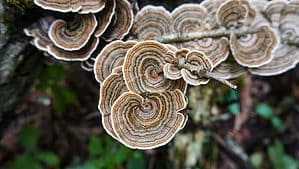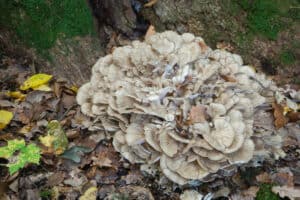Wondering what are the best types of mushrooms to grow at home? Well, you’ll be happy to know many species thrive in at-home grow kits, several of which are delicious, medicinal, or both!
In this guide, we’ll cover our top three picks of mushrooms to grow at home:
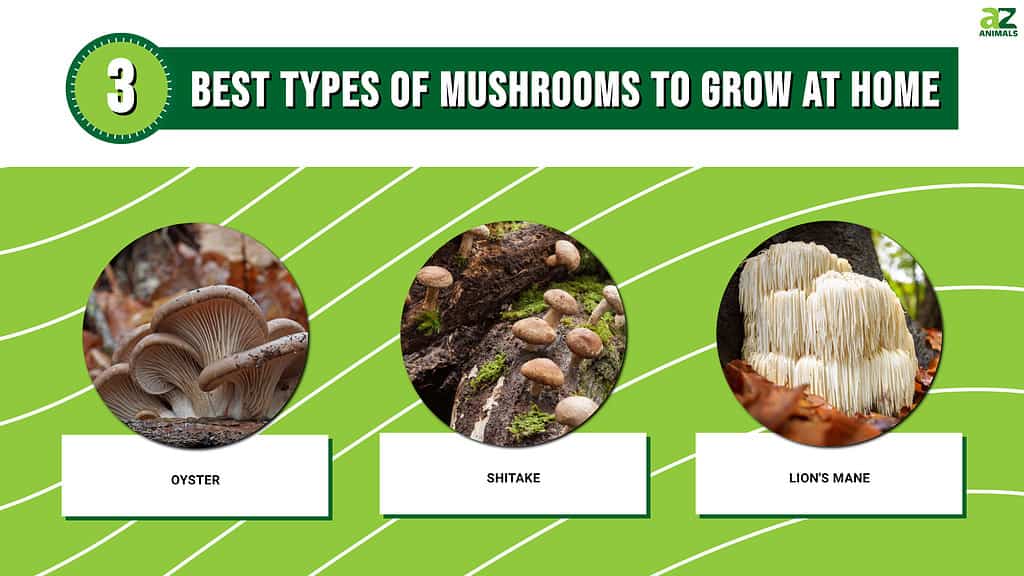
We’ll go into detail about home-growing these three mushrooms, what they’ll need to thrive, and what culinary/medicinal benefits they have. So, without further ado, let’s jump in!
1. Oyster Mushrooms
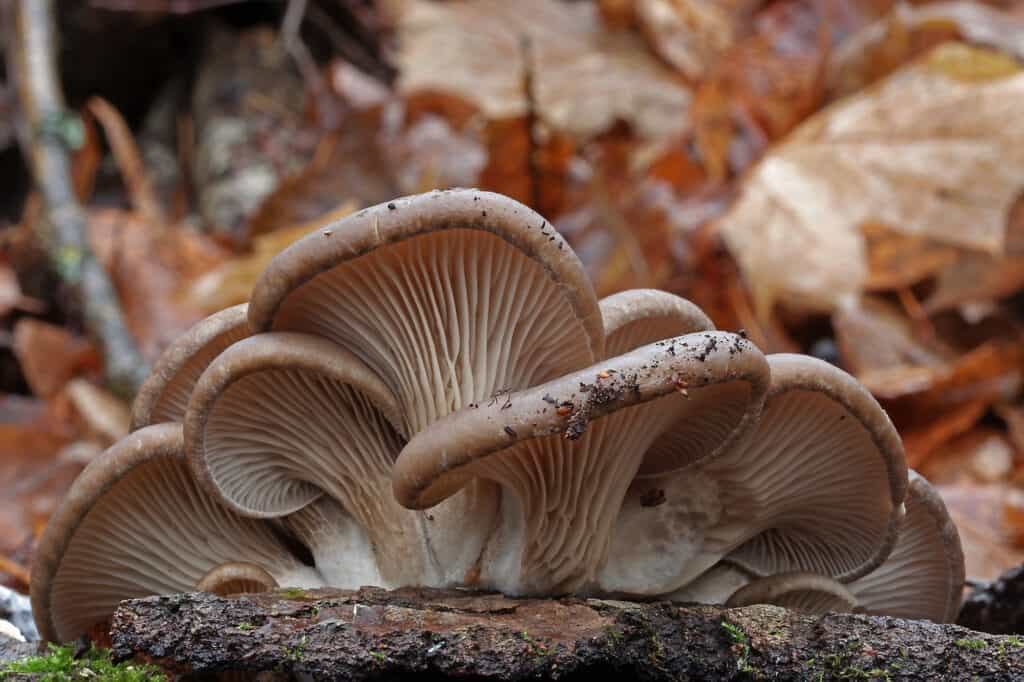
The clustered fashion that oyster mushrooms grow in may help with identification.
©NK-55/Shutterstock.com
Oyster mushrooms belong to the genus Pleurotus and represent the third most cultivated mushroom in the world. Dozens of wild and cultivated species exist, and luckily, people grow them because they are edible! Oyster mushrooms can range significantly in color, size, and length of the stipe (stem), but they all have prominent gills that run either partially or the full length of the stipe.
Typically, these mushrooms are found as fungi attached to decaying logs in the wild. Most common oyster species have cream, grey, or light brown caps, and short stipes. The gills are large, and typically run the length of the underside of the cap and stipe. The caps tend to expand and flatten out as they age. However, other wild species exist that have elongated stipes and convex caps, such as the king oyster mushrooms.
Popular species to grow at home include the pink oyster (Pleurotus djamor), golden oyster (Pleurotus citrinopileatus), king oyster (Pleurotus eryngii), and the common oyster (Pleurotus ostreatus).
Growing Substrates
Oysters are considered one of the easiest mushrooms to grow at home as they are hardy and can adapt to a wide range of growing substrates, including sawdust, cardboard, coffee grounds, and even a bag of kitty litter!
If growing outside, you can inoculate spawn (grown out spores) onto a variety of deciduous hardwood trees, like oak, beech, and aspen. You’ll want to select a log that has been cut down or fallen within the past two to three weeks. If the log has been sitting too long, the spawn will have to compete with other fungi. When the tree is too freshly cut or fallen, it may still release chemicals that prevent fungi from growing, but better early than late.
If you buy a grow kit, it will likely come with either a small inoculated log or a plastic bag with holes filled with sterilized, inoculated substrate, like sawdust. There are also ready to fruit kits where you just have to poke holes in it and mist from time to time to grow mushrooms.
Temperature, Light, and Humidity Requirements
So, depending on the species, the oysters will prefer to flush in a temperature range of 40°F to 85°F. King oyster mushrooms, for example, flush best at temperatures between 55°F and 63°F.
While the mycelium of oysters does not require light to grow, some degree of light is required for the fruiting bodies to flush. However, strong or even partial sunlight is not necessary for mushroom production. Periods of light exposure from an average reading lamp are often sufficient.
One study found that limited light exposure, in comparison to no light exposure, increased the concentration of health-benefiting polyphenolic compounds in the fruiting bodies of Pleurotus ostreatus. Some other studies have shown specific bandwidths of light may help some mushrooms absorb and contain more vitamin D.
To flush, oyster mushrooms require a high degree of humidity, ranging from 75%-95%. This degree of humidity is met by spraying the substrates or logs with water and ensuring consistent moisture once pins (small, immature fruiting bodies) start to appear.
Culinary Value
Oyster mushrooms are widely popular for culinary use. The fruiting bodies have a nice, subtle taste and pleasant texture.
These mushrooms are excellent battered and fried, in soups, pan-fried, as a meat substitute, in pasta, in dumplings, and more!
Medicinal Properties
Generally, oyster mushrooms are foraged and cultivated for culinary use, and limited studies have occurred on their potential medicinal uses. However, limited studies on some oyster mushroom species, such as Pleurotus ostreatus, do show potential for use in lowering high cholesterol, improving glucose metabolism, and improving cardiovascular health.
2. Shiitake Mushrooms
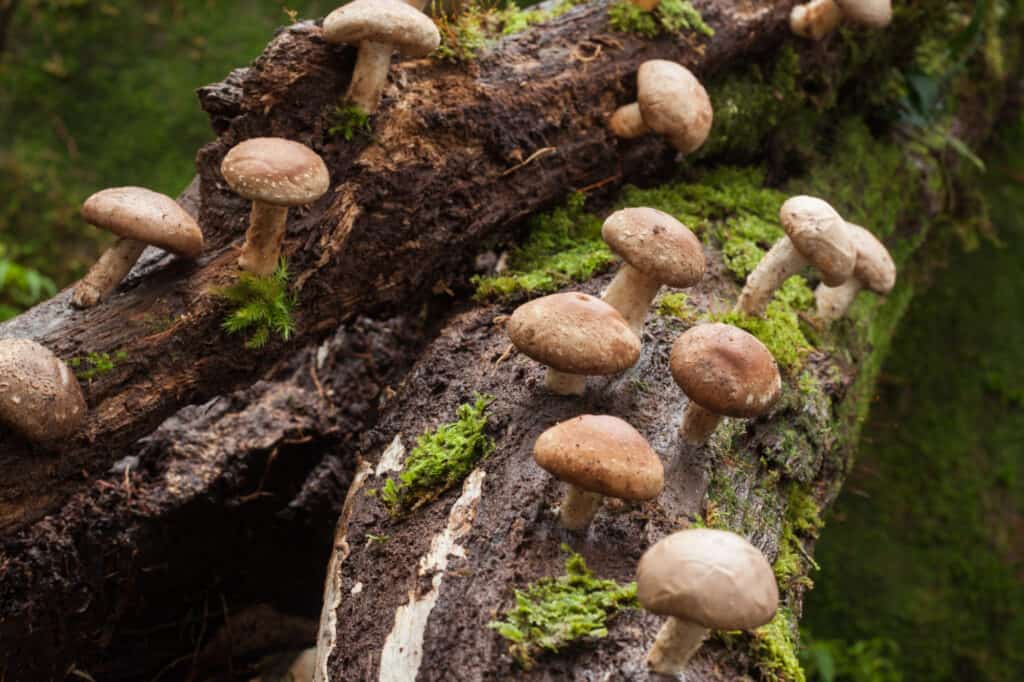
Most shitake mushrooms are sold dried or fresh.
©puttography/Shutterstock.com
A highly regarded choice edible, the shiitake mushroom (Lentinula edodes) is cultivated and sold around the world for its incredible texture, nutty, earthy taste, and potent medicinal properties.
Since they are saprobic mushrooms, you can cultivate shiitake mushrooms at home and enjoy these gourmet fungi in all their glory.
Growing Substrate
In the wild, shiitake mushrooms grow on decaying hardwood logs such as oak, alder, and walnut trees. You can either inoculate them into a log or hardwood sawdust.
Temperature, Light, and Humidity Requirements
Depending on the strain of shiitake, the mushrooms will fruit anywhere between 55-70°F ideally, but some strains can fruit in cooler and warmer temps. Strains are separated into cool temp, warm temp, and wide-ranging temperature categories. Make sure to know what your specific shiitake strain’s temperature requirement is for fruiting.
Shiitake mushrooms need 8-12 hours a day of indirect sun or supplemental lighting in order to trigger fruiting.
Additionally, you’ll need to keep the humidity at 80%-90% with consistent, fresh airflow.
Culinary Value
Around the world, people prized shiitake mushrooms for their culinary Value. These mushrooms have a wonderfully meaty, chewy texture and complex, savory, nutty taste. They make excellent meat substitutes in vegan dishes and are great additions to soups and grilled or pan-fried vegetable dishes. Additionally, many people dry these mushrooms to use for wonderfully rich soup broths. The stipes are pretty tough and many people use them just for stock, while eating the pileus (caps) as the main part of their meal.
Medicinal Properties
in addition to their amazing flavor profile, these mushrooms also may exhibit potent medicinal properties. Researchers have heavily studied shiitakes for their medicinal uses, and these mushrooms have a long history of use in traditional medicine.
One study found a particular aromatic compound in shiitake mushrooms, lenthionine, to have potent antimicrobial and antifungal properties. Another scientific review of published studies demonstrated the possibility of anticancer and immunomodulating effects with shiitake mushrooms.
3. Lion’s Mane Mushrooms
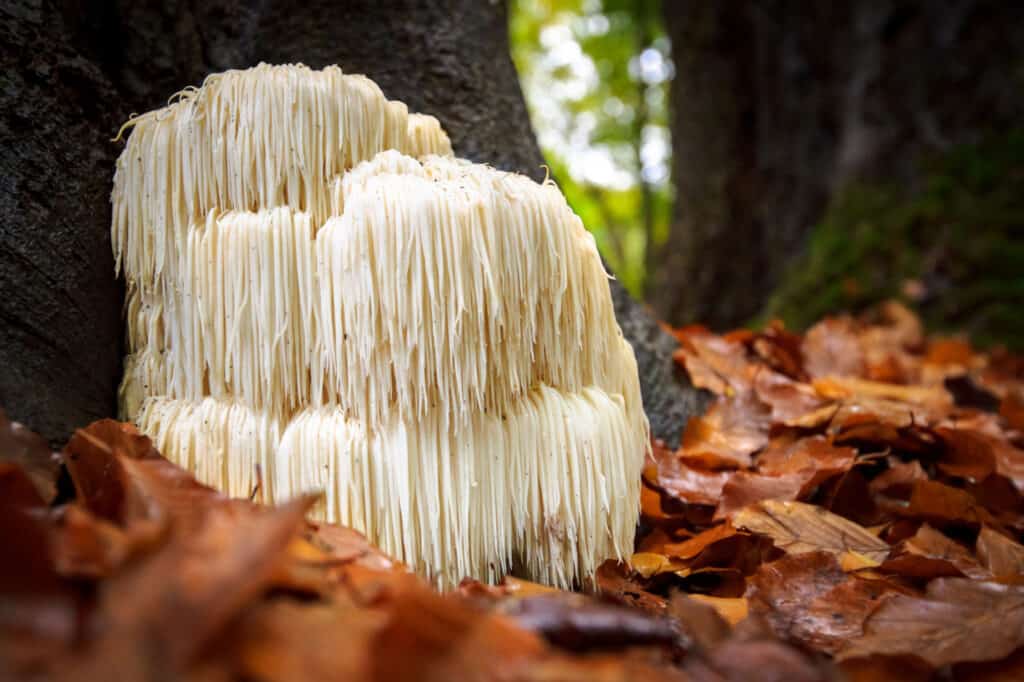
While they don’t look like traditional mushrooms, lion’s mane mushrooms are indeed edible.
©Fotografiecor.nl/Shutterstock.com
Perhaps less commonly known than shiitake or oyster mushrooms, lion’s mane mushrooms (Hericium erinaceus) are edible, highly medicinal fungi that you can grow at home.
These mushrooms are both saprobic and parasitic. This means they decompose and gain nutrients from dead organic matter, but they also derive nutrients from living organisms in a way that harms the host.
Growing Substrate
So, you can grow lion’s mane mushrooms from hardwood logs, like walnut, beech, and maple, or in bagged substrates. They can produce fruiting bodies in hardwood sawdust supplemented with rice bran, sterilized straw, and a 50-50 mix of hardwood sawdust and soy hulls.
Temperature, Light, and Humidity Requirements
To produce a plentiful lion’s mane harvest, you’ll need to maintain a temperature range of 65°F-75°F. Lion’s mane mushrooms do require some light in order to fruit, but the lighting requirement is pretty low. They need between 500-1,000 lumens to trigger flushing. For reference, a standard 40-watt bulb emits a little over 400 lumens. To fruit, these shaggy mushrooms require a high degree of humidity of 90%-95%.
Culinary Value
People who enjoy seafood tend to love this mushroom as it resembles the taste of lobster. A meaty mushroom, lion’s mane is particularly good grilled and pan-fried. Like lobster and shrimp, it pairs particularly well with buttery, lemon-pepper sauces.
Medicinal Properties
So, the medicinal properties of lion’s mane are heavily researched. It contains anti-inflammatory compounds and compounds that may stimulate neural nerve growth. In particular, researchers are studying the active neuro regenerative compounds in lion’s mane mushrooms as potential treatments for neurodegenerative diseases in humans such as Alzheimer’s and Parkinson’s disease. Additionally, the anti-inflammatory properties of lion’s mane are being studied as a treatment for gastrointestinal diseases such as ulcerative colitis. Finally, studies also show the ability of lion’s mane extracts to promote peripheral nerve regeneration after injury.
Summary of the 3 Best Types of Mushrooms to Grow at Home
| Name of Mushroom | Type of Fungi | Culinary Properties | Medicinal Potential |
|---|---|---|---|
| Oyster | Saprobic and weakly parasitic | Subtle taste and pleasant texture | Lower cholesterol, improve glucose and cardiovascular health |
| Shitake | Saprobic | Meaty, chewy, nutty | Antimicrobial, antifungal, anti-cancer, and immuno-modulating effects |
| Lion’s Mane | Saprobic and Parasitic | Meaty, with the taste of lobster | Neurodegenerative and gastrointestinal diseases and peripheral nerve regeneration |
The photo featured at the top of this post is © New Africa/Shutterstock.com
The information presented on or through the Website is made available solely for general informational purposes. We do not warrant the accuracy, completeness, or usefulness of this information. Any reliance you place on such information is strictly at your own risk. We disclaim all liability and responsibility arising from any reliance placed on such materials by you or any other visitor to the Website, or by anyone who may be informed of any of its contents. None of the statements or claims on the Website should be taken as medical advice, health advice, or as confirmation that a plant, fungus, or other item is safe for consumption or will provide any health benefits. Anyone considering the health benefits of particular plant, fungus, or other item should first consult with a doctor or other medical professional. The statements made within this Website have not been evaluated by the Food and Drug Administration. These statements are not intended to diagnose, treat, cure or prevent any disease.
Sources
- Beacon Hill Mushrooms, Available here: https://www.beaconhillmushrooms.co.uk/culture-library/1004-lions-mane/
- National Library of Medicine, Available here: https://www.ncbi.nlm.nih.gov/pmc/articles/PMC8401741/
- National Library of Medicine, Available here: https://pubmed.ncbi.nlm.nih.gov/29773008/
- National Library of Medicine, Available here: https://www.ncbi.nlm.nih.gov/pmc/articles/PMC7230384/
- Springer Nature, Available here: https://link.springer.com/article/10.1007/s11655-014-1624-2
Thank you for reading! Have some feedback for us? Contact the AZ Animals editorial team.




